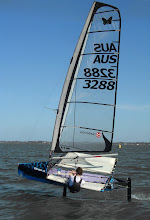heres the process:



The foil is longer than the last one, and the strut tapers. the hydrofoil is a higher lift section with a larger flap, as i found by doing this that the lift/drag ratio was generally better in that configuration because of the reduced area needed for takeoff. Top speed may suffer, we'll see. Also maxed out the span as much as i thought i could structurally with standard modulus carbon and wet layup (span is 1050mm). The flap is designed so that the deflection at the tips is limited to 5 or so degrees, and hopefully that should decrease induced drag when the flap is fully deflected up or down without affecting lift too much. I found that even though the tips twist down slightly, it is difficult to keep the lift distribution fairly elliptical when the flap is allowed to operate through its full range at the tip.
anyway, will lay up some bits when i get time. might have to wait till the new year.







11 comments:
wow! looks nice!
yes wow - looks nice! Could you send a rhino file or cnc file? Want to try my cnc machiene to have a idear how it works!
Would be great - need not be a full piece! Thanks Niki
cheers guys, we'll see if it comes out alright. bit worried about the strength of the horizontal and T joint.
niki, whats your email? alternatively just email me
flutter (dot) n (at) gmail (dot) com
I was going to link the files to the post but I think they are too big, so ill just send you some bits and pieces.
nick
You seem to have opted for a very narrow flap, based on the distance between the socket and the trailing edge. Current trends is for a much wider flap especially mid span, hence the almost diamond shaped plan form of the BR and More so on the M2.
It seems to make for an easier and earlier take off.
Well done - it is simply amazing that amateur moth designers/builders have been able to up the level of professionalism in their boats to the extent shown in your post. Who would have thought five years ago that one of the steps to building a moth would involve CAD design of a foil and occasionally building a CNC machine! Good luck with the foils!
Super cool stuff, all the more impressive having done it on a router you designed and built (!)
Phil looks like the mainfoil tool doesn't include the flap, with a separate tool visible in the photo above. It's a sizable flap.
The strength of the T seems like a good thing to worry about, unless you are planning to build an autoclave next...a solid foil inspires confidence. Would be v. impressive if you can pull it off - I mean, if it holds together!
What section are you using?
thanks for the encouragement!
Phil, yep the foil and the flap are separate tools. made sense to think of them as separate bits just to keep a clear head laminating them really. the flap is between 35 and 40% in the middle, and down to 25 - 30% at the tips. about the same as current models i think. once it gets bigger than 40% it starts to suck, i found, so thats why its that size.
The section is based on the last foil - NACA 64- something or other. (looked it up) 64-612 at the root and 64-608 at the tip, tapers off pretty early. so its a more cambered section than before, so the foil is smaller than before. It just seemed to give a higher lift/drag so you cant argue with that? (probably can) dunno, seemed like a fair enough starting point.
reno08 i checked out your blog, cool stuf ill read it a bit better when i get a chance.
Good to see peeps doing this sort of thing - is that Sikablock you are using for tooling board?
naa its just MDF.
only found out about tooling boards last week when i went to buy carbon. the tools were already cut. next time. the learning curve is still steep!
Hi Nick, ever thought of making a single foil? I've made a few for sailboards and they should translate to moths pretty easily..
Cheers, Brett in Sydney.
Brett,
I haven't really thought of it to be honest, but i'm open to anything! Send me a pic of one? flutter (dot) n (at) gmail (dot) com. How do they perform? (i assume very well) Moths do seem to rely on the rudder quite a bit for pitch stability, so I'm keen to know what the key is for achieving that in your case, sans rudder. like do you just tilt the board with your weight?
Post a Comment